Papers by Jan-erik Svensson
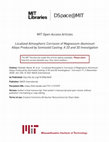
Corrosion, Nov 24, 2020
The localized corrosion of the two magnesium-aluminum alloys AM50 and AZ91 produced by a semisoli... more The localized corrosion of the two magnesium-aluminum alloys AM50 and AZ91 produced by a semisolid casting method was investigated under atmospheric corrosion conditions, in the presence of NaCl. Gravimetry confirmed the beneficial effect from ambient levels of carbon dioxide (CO2) in suppressing corrosion through the formation of magnesium hydroxy carbonates. Both 2D and 3D characterization revealed that ambient CO2 has a strong influence on the morphology and rate of localized corrosion. In CO2-free atmosphere, the alloys suffered localized corrosion resulting in clustered and interconnected cavities that extended deep into the material. In contrast, corrosion in the presence of ambient levels of CO2 (400 ppm) resulted in evenly distributed shallow corrosion sites. The results indicate that CO2 neutralizes the cathodic areas resulting in diminished cathodic activity and inhibiting NaCl(aq) droplet coalescence.
A field campaign and laboratory exposures have been performed. Comparably high concentrations of ... more A field campaign and laboratory exposures have been performed. Comparably high concentrations of acetic and formic acid vapour are present in the wind system of heavily corroded baroque organs in Europe. The corrosivity of these gases is investigated in lab exposures of polished samples. Corrosion rate was measured gravimetrically and the corrosion products were analysed qualitatively and quantitatively. The atmospheric corrosion of lead is strongly accelerated by traces of acetic acid (ethanoic acid). The results imply that acetic acid vapour is a very important corrosive agent for lead pipes in historical organs. Formic acid (methanoic acid) is slightly less corrosive than acetic acid. Water leaching has no apparent effect on the corrosion rate of lead in the presence of acetic acid vapour.
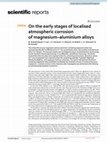
Scientific Reports, Dec 1, 2020
The surface film on pure magnesium and two aluminium-containing magnesium alloys was characterise... more The surface film on pure magnesium and two aluminium-containing magnesium alloys was characterised after 96 h at 95% RH and 22 °C. The concentration of CO 2 was carefully controlled to be either 0 or 400 ppm. The exposed samples were investigated using X-ray photoelectron spectroscopy, Fourier transform infrared spectroscopy, X-ray diffraction, and electron microscopy. The results showed that when the alloys were exposed to the CO 2-containing environment, aluminium cations (Al 3+) was incorporated into a layered surface film comprising a partially "hydrated" MgO layer followed by Mg(OH) 2 , and magnesium hydroxy carbonates. The results indicated that aluminiumcontaining magnesium alloys exhibited considerably less localised corrosion in humid air than pure magnesium. Localised corrosion in the materials under investigation was attributed to film thinning by a dissolution/precipitation mechanism. The characteristics of the surface film formed upon magnesium and its alloys are significant in the context of corrosion. When exposed to air (O 2) or low concentrations of water vapour, magnesium forms a thin (2-3 nm), Cabrera-Mott type oxide (MgO) film, which protects the metal against further oxidation 1. The chemistry and properties of the thin oxide layer are largely impacted by water (vapour). Many workers have to date employed high-resolution analytical tools to investigate the characteristics of the surface films formed upon magnesium and its alloys after exposure to various environments 2-8. Examples of the surface-sensitive techniques that have to date provided useful information in this context include transmission electron microscopy (TEM) 2-6 , X-ray photoelectron spectroscopy (XPS) 9,10 , and Auger electron spectroscopy (AES) 8,11-13. In the early 1990s, Splinter et al. 14 utilised XPS, AES, and nuclear reaction analysis (NRA) to examine the water-magnesium interactions at the sub-micron scale. They reported on the formation of MgO with traces of hydrogen at the metal/oxide interface and suggested 'it is likely as hydroxy groups trapped in the film'. Nordlien et al. 15 used TEM, for the first time, to study the surface film formed on magnesium exposed to air, water (vapour). They observed a 'dense' air-formed MgO film, which was transformed into amorphous Mg(OH) 2 platelets in the presence of water. Nordlien et al. 16,17 also examined the film formed on magnesium-aluminium alloys and suggested that an 'alumina component' was formed in the innermost layer of the film, contributing to alloys' corrosion performance. More recently, Santamaria et al. 18 used XPS and photocurrent spectroscopy (PCS) to investigate the surface film formed on magnesium when immersed in liquid water. They reported on the formation of a bilayer film consisting of a thin MgO inner layer and a magnesium hydroxide top layer. Similar results were reported by Taheri et al. 2,3 who employed FIB and TEM to study the structure and composition of the surface film formed on magnesium after exposure to liquid water and humid air. In atmospheric corrosion, the surface electrolyte, which is sourced by adsorbed or liquid water from the atmosphere, plays a key role in the dissolution process. At a given temperature, the equilibrium amount of adsorbed water on a surface is a function of relative humidity (RH) 1,19,20. At room temperature, the amount of water at 20% RH corresponds to about one monolayer while about 10 monolayers (~ 3 nm) of water are present at 95% RH 19. In the latter case, the aqueous layer has liquid-like properties. Hence, to understand the role of the surface electrolyte in the corrosion process under atmospheric conditions (i.e. in the presence of monolayers of electrolyte, deicing salt, and atmospheric pollutants), it is necessary to investigate the corrosion of magnesium alloys
Oxidation of Metals, Feb 12, 2015
Early oxide scale growth on an oxide dispersion strengthened rapidly solidified powder FeCrAl mat... more Early oxide scale growth on an oxide dispersion strengthened rapidly solidified powder FeCrAl material, Kanthal Ò APMT, was investigated at 900°C in an O 2 ? N 2 and an O 2 ? H 2 O ? N 2 environment for up to 168 h. Gravimetry was used to follow oxide growth and the oxide scale was examined with XRD. Scale morphology was investigated in detail with SEM/EDX, TEM/EDX/CBED. The alloy rapidly formed a protective two-layered a-alumina scale containing oxide nodules. Between the top and bottom alumina layers there was a zone containing chromia-rich particles 5-20 nm in diameter, corresponding to the original sample surface. The alumina scale mainly grew inward after 1 h of oxidation. Alumina scale growth at 900°C was initially somewhat faster in an O 2 ? H 2 O ? N 2 environment than in an O 2 ? N 2 environment.
Oxidation of Metals, Jan 22, 2021
A new approach to reduce the chromium and aluminium concentrations in FeCrAl alloys without signi... more A new approach to reduce the chromium and aluminium concentrations in FeCrAl alloys without significantly impairing corrosion resistance is to alloy with 1-2 wt.% silicon. This paper investigates the "silicon effect" on oxidation by comparing the oxidation behavior and scale microstructure of two FeCrAl alloys, one alloyed with silicon and the other not, in dry and wet air at 600 °C and 800 °C. Both alloys formed thin protective oxide scales and the Cr-evaporation rates were small. In wet air at 800 °C the Si-alloyed FeCrAl formed an oxide scale containing mullite and tridymite together with α-and γ-alumina. It is suggested that the reported improvement of the corrosion resistance of Al-and Cr-lean FeCrAl's by silicon alloying is caused by the appearance of Si-rich phases in the scale.
Oxidation of Metals, Mar 28, 2022
The effect of hydrogen on oxygen permeability has been studied in a diluted Pd-Cr alloy in dual-a... more The effect of hydrogen on oxygen permeability has been studied in a diluted Pd-Cr alloy in dual-and single-atmosphere conditions between 600 and 950 °C. The 0.3 mm thick Pd-1.5Cr foil was exposed in dry and humid air as well as in dualatmosphere conditions, with one sample surface being exposed to air and one to hydrogen, as encountered in solid oxide fuel cells. At all temperatures, Cr oxidized internally forming internal oxidation zones which were measured in metallographic cross sections. Below 800 °C, an external layer of PdO formed on the surface decreasing the internal oxidation kinetics. No measurable effect of hydrogen on the internal oxidation of Cr in Pd has been detected.
Oxidation of Metals, Oct 31, 2014
The present study investigates the influence of H 2 O and KCl on the high temperature corrosion o... more The present study investigates the influence of H 2 O and KCl on the high temperature corrosion of an FeCrAl alloy at 600°C. Polished samples were exposed to O 2 or O 2 ? H 2 O and to O 2 ? H 2 O with KCl applied. The samples were investigated using SEM/EDX, XRD, IC, AES and SIMS. It was found that KCl accelerates corrosion and that a rapidly growing iron-rich oxide forms with time. Chromate formation is shown to initiate the formation of a non-protective oxide scale. Pre-oxidising the alloy before exposure in the presence of KCl had a strongly beneficial effect on the corrosion.
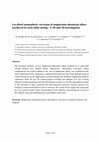
The localised corrosion of two magnesium-aluminium alloys produced by a semi-solid casting method... more The localised corrosion of two magnesium-aluminium alloys produced by a semi-solid casting method was studied herein. Specifically, atmospheric corrosion, which comparatively less widely studied in the case of magnesium alloys, was explored for the alloys AM50 and AZ91. Gravimetry confirmed the beneficial effect from ambient levels of carbon dioxide (CO2) in suppressing corrosion through the formation magnesium hydroxy carbonates. Both 2D and 3D characterisation revealed that ambient CO2 has a strong influence on the morphology and rate of localised corrosion. A CO2-free atmosphere resulted in the formation of deep, clustered and interconnected corrosion, whereas ambient CO2 resulted in isolated and shallow surface corrosion. The results herein support the notion that the CO2 induced acidity causes neutralisation of the catholyte, diminishing the activity of the cathodic areas and inhibiting NaCl (aq) droplet coalescence.
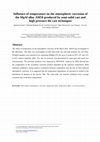
The effect of temperature on the atmospheric corrosion of the MgAl alloy AM50 was investigated in... more The effect of temperature on the atmospheric corrosion of the MgAl alloy AM50 was investigated in the laboratory. The alloy was investigated in both semi-solid cast and high pressure die cast form. Polished samples were exposed to air containing 400ppm CO 2 for up to 4 weeks at 22ºC, 4ºC and-4 o C at 95% relative humidity (RH). The rate of corrosion was determined by mass gain and metal loss measurements. The corrosion products were analyzed by SEM/EDX. Analysis by XRD showed that the composition of the crystalline corrosion product depended on the exposure temperature. Both materials exhibited a strong positive correlation between temperature and the rate of NaCl-induced atmospheric corrosion. It is suggested that the temperature dependence of corrosion is related to the dissolution of alumina in the passive film. The semi-solid cast material exhibited lower average corrosion rates at all three temperatures.
Oxidation of Metals, Jun 28, 2022
Internal oxidation of Fe-2.25Cr has been studied in Fe/FeO Rhines pack (RP) and H 2 /H 2 O gas mi... more Internal oxidation of Fe-2.25Cr has been studied in Fe/FeO Rhines pack (RP) and H 2 /H 2 O gas mixtures at 700-900 °C. A novel exposure technique allowing RP experiments in dual atmosphere conditions was developed. No measurable effect of hydrogen on lattice oxygen permeability in ferrite could be detected: neither in single nor in dual atmosphere conditions. The H 2 /H 2 O atmosphere was found to induce stronger oxidation attack at alloy grain boundaries resulting in a morphology similar to intergranular stress corrosion cracking often reported in nuclear technology. The intergranular oxidation attack was demonstrated to be independent of the dual atmosphere effect, i.e., hydrogen dissolved in the alloy.
Oxidation of Metals, Mar 18, 2015
The corrosion behaviour of a FeCrAl alloy was investigated at 600°C in O 2 ? H 2 O with solid KCl... more The corrosion behaviour of a FeCrAl alloy was investigated at 600°C in O 2 ? H 2 O with solid KCl applied. A kinetics and microstructural investigation showed that KCl accelerates corrosion and that potassium chromate formation depletes the protective scale in Cr, thus triggering the formation of a fast-growing iron-rich scale. Iron oxide was found to grow both inward and outward, on either side of the initial oxide. A chromia layer is formed with time underneath the iron oxide. It was found that although the alloy does not form a continuous pure alumina scale at the investigated temperature, aluminium is, however, always enriched at the oxide/alloy interface.
The corrosion of lead-tin organ pipes is a major threat to historical organs in Europe. A strong ... more The corrosion of lead-tin organ pipes is a major threat to historical organs in Europe. A strong corrosion factor is the emission of organic acids from the wooden parts in the organ. The main objective of the present work is the creation of conservation strategies for lead based organ pipes. To this aim, the protective efficiency of different surface treatments has been evaluated. The accelerated exposure tests in acetic acid atmosphere reveal that none of the selected treatments guarantees long-term protection. Therefore the best conservation strategy is the preventive approach of changing the environment. An innovative nanotechnology treatment for the deacidification of wood samples has been studied. This method seems indeed to be promising in order to effectively decrease the high levels of acetic acid vapour in the organ environment
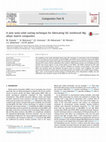
Composites Part B: Engineering, 2016
The capability of the newly developed rheocasting (RC) technique in combination with the RheoMeta... more The capability of the newly developed rheocasting (RC) technique in combination with the RheoMetal process for producing SiC particulate-reinforced AM50 and AZ91D matrix composites (Mg-based MMCs) was investigated. The quality of the MMCs was studied by analyzing the fraction of casting pores, number density of SiC clusters and the uniformity of SiC particles. Solid fraction, particle size and oxidation of SiC particles had strong impacts on the overall quality of the MMCs. The MMCs produced by 40% solid fraction and oxidized micron-sized SiC particles exhibited an excellent casting quality. A low-quality MMC was obtained when non-oxidized sub-micron sized SiC particles were employed. The results showed the formation of various types intermetallic particles and carbides such as MgO, Mg 2 Si, Al 2 MgC 2 , Mg 2 C 3 , Al 4 C 3 as the interfacial reaction products of SiC/Mg alloy's melts. Mg hydride (a-MgH 2) was also identified in inter-dendritic regions of the MMCs for the first time.
ECS Transactions, 2021
Cathode poisoning by chromium evaporation from the interconnects is one of the major degradation ... more Cathode poisoning by chromium evaporation from the interconnects is one of the major degradation mechanisms in SOFC. Coatings have proved to be very effective in suppressing chromium evaporation on interconnects. The quantification of chromium evaporation is important for determining the chromium consumption in the interconnect and predicting the lifetime of the interconnect. Chromium evaporation of uncoated and Ce/Co coated Crofer 22 APU is reevaluated at 800°C. The chromium evaporation of Ce/Co coatings on steel sheets and precut steels is studied. Coupons cut from Ce/Co coated sheets have uncoated edges, which influence the chromium evaporation measurements. The true chromium evaporation of the coated interconnects is evaluated. The PVD Ce/Co coatings on Crofer 22 APU reduce the chromium evaporation by at least 60 times compared to the uncoated at 800°C.

Oxidation of Metals, 2019
The influence of alkali- and chlorine-containing compounds on the corrosion of superheater alloys... more The influence of alkali- and chlorine-containing compounds on the corrosion of superheater alloys has been studied extensively. The current paper instead investigates the corrosive effects of KCl and HCl under conditions relevant to waterwall conditions. A low-alloy (Fe-2.25Cr-1Mo) steel was exposed to KCl(s), 500 vppm HCl(g) and (KCl + HCl) in the presence of 5%O2and 20% H2O at 400 °C. The results indicate that alloy chlorination by KCl occurs by an electrochemical process, involving cathodic formation of chemisorbed KOH on the scale surface and anodic formation of solid FeCl2at the bottom of the scale. The process is accompanied by extensive cracking and delamination of the iron oxide scale, resulting in a complex, convoluted scale morphology. Adding 500 vppm HCl to the experimental environment (KCl + HCl) initially greatly accelerated the formation of FeCl2at the scale/alloy interface. The accelerated alloy chlorination is attributed to HCl reacting with KOH at the scale surface,...

Oxidation of Metals, 2015
The effect of p(H 2 O) and p(H 2) on the oxidation of 304L stainless steel at 600°C has been inve... more The effect of p(H 2 O) and p(H 2) on the oxidation of 304L stainless steel at 600°C has been investigated in the present study. The samples were analysed by means of X-ray diffraction, Auger spectroscopy, and scanning electron microscopy equipped with energy dispersive spectroscopy. The results showed that at fixed p(H 2), the corrosion rate increased considerably with increasing p(H 2 O). At fixed p(H 2 O), the corrosion rate decreased slightly with increasing p(H 2). Duplex oxide scales formed during the exposure in all environments. The outer and inner layer consisted of Fe 3 O 4 and (Fe, Cr) 3 O 4 , respectively. The latter was mainly in the form of internal oxidation. The Cr-rich oxide formation was observed at the initial oxidation process before oxide breakdown. The Auger analysis also suggested the presence of Cr-rich oxide layer just after the breakaway oxidation. The results indicated that the rate-determining step in the corrosion attack is surface controlled or diffusion controlled through an oxide layer with fixed thickness over time.
Oxidation of Metals, 2015
The KCl-induced corrosion of the FeCrAl alloy Kanthal Ò APMT in an O 2 ? N 2 ? H 2 O environment ... more The KCl-induced corrosion of the FeCrAl alloy Kanthal Ò APMT in an O 2 ? N 2 ? H 2 O environment was studied at 600°C. The samples were pre-oxidized prior to exposure in order to investigate the protective nature of alumina scales in the present environment. The microstructure and composition of the corroded surface was investigated in detail. Corrosion started at flaws in the pre-formed a-alumina scales, i.e. a-alumina was protective in itself. Consequently, KCl-induced corrosion started locally and, subsequently, spread laterally. An electrochemical mechanism is proposed here by which a transition metal chloride forms in the alloy and K 2 CrO 4 forms at the scale/gas interface. Scale de-cohesion is attributed to the formation of a sub-scale transition metal chloride.





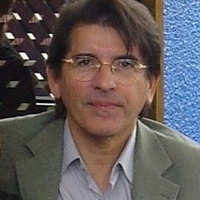
Uploads
Papers by Jan-erik Svensson